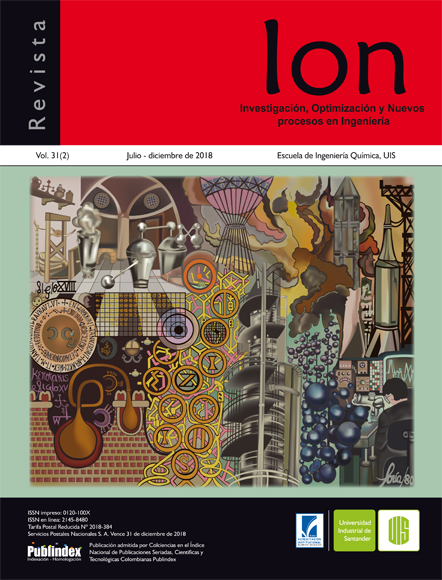Effect of water saturation during the ignition of an in situ combustion process
Published 2019-01-17
Keywords
- combustão in-situ,
- prova de celular isotérmica,
- Ignição Espontâneo,
- MATLAB
How to Cite
Copyright (c) 2018 Revista Ion

This work is licensed under a Creative Commons Attribution 4.0 International License.
Abstract
In Situ Combustion (ISC) is a thermal method for the enhanced heavy oil recovery. To start the ISC process is necessary to consume a part of the oil in the reservoir by means of the oxidation reactions, then maintain combustion by continuous air injection. This initial stage is known as ignition and its study allows to identify the energy requirement of the rock-fluid system. Proper research of ignition could lead to successful ISC field trial.
The purpose of the present project is to predict the spontaneous ignition of a Colombian heavy oil reservoir through a mathematical model programmed in MATLAB, which took into account a combined mass and heat transfer of the reactions that occur in the low temperature oxidation (LTO) regime. The kinetic parameters were obtained from the isothermal cell tests performed in the Air Injection Laboratory of the Instituto Colombiano del Petróleo. The results showed the direct effect of the water saturation on the delay ignition and the ignition distance from the injector well.
Downloads
References
[2] Xia T, Greaves M, Turta A, Ayasse C. THAI – A ‘short-distance displacement’ in situ combustion process for the recovery upgrading of heavy oil. Chem. Eng. Res. Des. 2003;81:295–304.
[3] Instituto Colombiano del Petróleo, ECOPETROL S.A. Determinación del mecanismo de ignición, del tiempo de retardo y de los efectos del aceite de linaza para la inyección de aire en el campo Chichimene. Piedecuesta, Colombia: Lizcano H; 2015.
[4] Bilijderveen M. Ignition and combustion phenomena on a movin grate (tesis doctoral).Enschede, Netherlands: University of Twente; 2011.
[5] Turta A. In Situ Combustion. En: Enhanced Oil Recovery: Field cases studies. London: Gulf Professional Publishing; 2013. p. 447 – 541. ISBN-13: 978-0123865458.
[6] Burger J, Sahuquet B. Chemical aspects of in situ combustion-heat of combustion and kinetics. Soc. Pet. Eng. Journal. 1972;5(12):410-22.
[7] Khansari Z. A new reaction model for low temperature oxidation of heavy oil: Experiments and numerical modeling. Energy Elsevier. 2014;64:419–28.
[8] Lee D, Noureldin N. Effect of Water on the Low – Temperature Oxidation of Heavy Oil. Energy & Fuels. 1989;3:713-5.
[9] Klock K, Hascakir B. Simplified Reaction Kinetics Model for In-Situ Combustion. Society of Petroleum Engineers; 2015. SPE-177134-MS.
[10] Schoeppel R, Ersoy D. Prediction of Spontaneous Ignition in In-Situ Combustion. Society of Petroleum Engineers; 1968. SPE 2383.
[11] Tadema H, Wijedma J. Spontaneous Ignition of Oil Sands. The Oil and Gas Journal. 1970;68(50):77–80.
[12] Burger J. Spontaneous Ignition in Oil Reservoirs. Society of Petroleum Engineers Journal. 1976;16(2):73–81.
[13] Agca C, Yortsos YC. Steady-State Analysis of In-Situ Combustion. United States: Society of Petroleum Engineers; 1985.
[14] Aguillon M. Análisis de la etapa de ignición en la combustión in situ de crudo pesado (tesis pregrado). Medellin, Colombia: Universidad Nacional de Colombia; 2016.
[15] Rao N, Roychaudhury S, Sapkal A, Gupta K, Sinha S. Results Of Spontaneous Ignition Test in Balol Heavy Oil Field. Society of Petroleum Engineers; 1997. SPE-38067. p.435 – 441.
[16] Khansari Z. Low Temperature Oxidation of Heavy Crude Oil: Experimental Study and Reaction Modeling (tesis doctoral). Calgary, Canada: Department of Chemical and Petroleum Engineering-University of Calgary;2014.
[17] Grupo de Investigación Recobro Mejorado, Universidad Industrial de Santander. Estudio de Combustión In Situ utilizando configuraciones horizontales en yacimiento: ventajas y desventajas. Bucaramanga, Colombia: Dangon J, Muñoz S, Rojas J; 2016.

